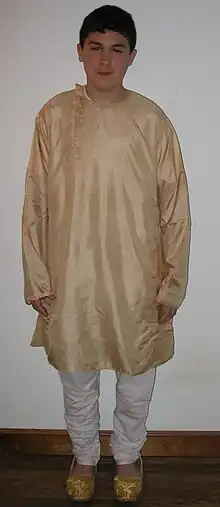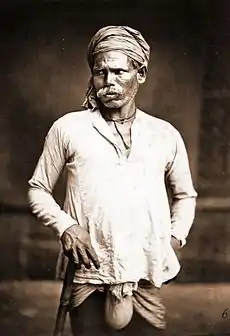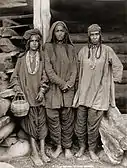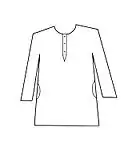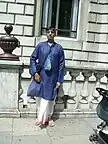Kurta
A kurta is a loose collarless shirt or tunic worn in many regions of South Asia,[1][2][3] and now also worn around the world.[4] Tracing its roots to Central Asian nomadic tunics, or upper body garments, of the late-ancient- or early-medieval era, the kurta has evolved stylistically over the centuries, especially in South Asia, as a garment for everyday wear as well as for formal occasions.[5]
The kurta is traditionally made of cotton or silk. It is worn plain or with embroidered decoration, such as chikan; and it can be loose or tight in the torso, typically falling either just above or somewhere below the knees of the wearer.[4] The front and back of a traditional kurta are made of rectangular pieces, and its side-seams are left open at the bottom, up to varying lengths, to enable ease of movement.[4]
The sleeves of a traditional kurta fall to the wrist without narrowing, the ends hemmed but not cuffed; the kurta can be worn by both men and women; it is traditionally collarless, though standing collars are increasingly popular. Kurtas are traditionally worn over ordinary pajamas,[5] loose shalwars, or churidars. Among urban youth, kurtas are being increasingly worn over jeans,[6] not only in South Asia,[7] but also in the South Asian diaspora, both the recently established,[8] and the longstanding.[9] Young women and girls in urban areas are increasingly wearing kurtis, which are short hip-length kurtas, with jeans or leggings, in addition to more traditional lower-body garments.[10]
Etymology
- According to the Oxford Dictionary of English,[2]
"kurta (n): "A loose collarless shirt worn by people from South Asia, usually with a salwar, churidars, or pyjama. From Urdu and Persian kurtah."
- According to the Oxford English Dictionary (online, subscription required)[11] The first use of kurta in English is attributed to W.G. Lawrence in T. E. Lawrence, Home Letters, 1913, "Me in a dhoti khurta, White Indian clothes."
- According to Cannon and Kay's, The Persian Contributions to the English Language: A Historical Dictionary, 2001,[12]
"kurta, n. (Ogilby 1673: 50) Cloth., var. khurta, kurtha + 1 [Persian. a tunic, waistcoat, jacket & Hindi & Urdu ( < Persian.)] A loose shirt or tunic worn by Persian men and now esp. by Indians; a woman's dress resembling the man's kurta, popular in the West."
- According to Platt's, A Dictionary of Urdu, Classical Hindi, and English, 1884, online, updated 2015,[13]
" Persian کرته kurta , s.m. A shirt worn outside the drawers; a frock, a kind of tunic; a waistcoat or jacket."
- According to McGregor's Oxford Hindi-English Dictionary:[14]
कुरता kurtā: (Persian. masculine), a collarless shirt".
- According to Winer's Dictionary of the English/Creole of Trinidad & Tobago: On Historical Principles, 2009,[15]
"kurti, kurtee n A traditional form of Indian woman's long loose-fitting tunic, with long sleeves. /kurti/ * Usually the Kurti was longer than male's Kurta, for sometimes it reached down [past] the knees. (Raghoo 1984:3) * "She use to wear long dress and kurtee and tie a handkerchief on her head." (Deen 1994:167)"
- According to Steingass's A Comprehensive Persian-English Dictionary, 1892 (updated 2007),
کرته kurta, A tunic, waistcoat, jacket; a long loose-skirted under-gown or shirt; a shirt. کرتی kurtī, A waistcoat for women, a short bodice reaching to the hips, with very short, if any sleeves, open under the throat; a soldier's jacket.[16]
Arabic قرطق qurt̤aq (Persian. كرته kurta), A kind of garment. Arabic قرطقة qartaqat (v.n. of قرطق), Putting the garment qurt̤aq on (any person).[17]
History
According to author Roshen Alkazi, stitched (i.e. cut and sewn) attire came to South Asia from Central Asia. There was a trickle during the Scythian/Parthian/Kushan invasions of the late ancient period.[19] with Mahmud of Ghazni, the floodgates opening with the Muslim conquests of the late 12th century, until the kurta became an item of common attire during the early modern era.[20][21]
According to Alkazi:[18]
...In the Ghaznavid period, we have only one clear visual reference to their actual costume, those worn by the Mamluk (slave) palace guards of Mahmud of Ghazni, in the wall paintings of Lashkari Bazaar in Afghanistan. They wear the qaba made of rich patterned textiles. This was a mid-calf length tunic with long narrow sleeves and tiraz. The opening is from right to left and has a small loop for closing it higher at the left shoulder. This closing at the left shoulder was one of the earliest forms of neck closing and a relic of this is still seen in the Russian tunic and in the contemporary kurtas used in certain parts of India, both of which close at the left shoulder. (p 467)
Styles


A traditional kurta is composed of rectangular fabric pieces with perhaps a few gusset inserts, and is cut so as to leave no waste fabric. The cut is usually simple, although decorative treatments can be elaborate.
The sleeves of a traditional kurta fall straight to the wrist; they do not narrow, as do many Western-cut sleeves. Sleeves are not cuffed, just hemmed and decorated.
The front and back pieces of a simple kurta are also rectangular. The side seams are left open for 6-12 inches above the hem, also referred to as the chāk, which gives the wearer some ease of movement. (Note: chāk derives from the Persian "چاك ćāk, Fissure, cleft, rent, slit, a narrow opening intentionally left in clothes)."[22]
The kurta usually opens in the front; some styles, however, button at the shoulder seam. The front opening is often a hemmed slit in the fabric, tied or buttoned at the top; some kurtas, however, have plackets rather than slits. The opening may be centered on the chest, or positioned off center.
A traditional kurta does not have a collar. Modern variants may feature stand-up collars of the type known to tailors and seamstresses as "mandarin" collars. These are the same sort of collars seen on achkans, sherwanis, and Nehru jackets.
Material

Kurtas worn in the summer months are usually made of thin silk or cotton fabrics; winter season kurtas are made of thicker fabric such as wool or "Khadi silk", a thick, coarse, handspun and handwoven silk that may be mixed with other fibers. A very common fabric for the kurta pajama is linen, or a linen-cotton mix ideal for both summers and winters.
Kurtas are typically fastened with tasselled ties, cloth balls, and loops, or buttons. Buttons are often wood or plastic. Kurtas worn on formal occasions might feature decorative metal buttons, which are not sewn to the fabric, but, like cufflinks, are fastened into the cloth when needed. Such buttons can be decorated with jewels, enameling, and other traditional jewelers' techniques.
Decoration
Tailors from the South Asia command a vast repertoire of methods, traditional and modern, for decorating fabric. It is likely that all of them have been used, at one time or another, to decorate kurtas. However, the most common decoration is embroidery. Many light summer kurtas feature Chikan embroidery, a specialty of Lucknow, around the hems and front opening. This embroidery is typically executed on light, semi-transparent fabric in a matching thread.
Regional variants
Regional styles include the Bhopali, Hyderabadi, Lucknowi and straight-cut kurtas. The Bhopali kurta (taking its name from Bhopal) is a loose kurta with pleats at the waist, flowing like a skirt reaching midway between the knees and the ankles.[23] It is worn with a straight pajama.[24] [note 1] The Hyderabadi kurta is named after the former royal state of Hyderabad and is a short top which sits around the waist, with a keyhole neck opening. It was popular with the local royal households.[27][28] Traditionally, the Hyderabadi kurta was of white material,[29] but modern versions can be of any colour. Over the kurta, some versions have net material, the combination of which is called jaali karga, worn by men and women.[30] The traditional Lucknowi kurta can either be short[31] or long, using as much as 12 yards of cloth.[32] The traditional Lucknowi kurta styles have an overlapping panel.[33] However, the term "Lucknowi kurta" now applies to the straight-cut kurta embroidered using local Chikan embroidery. Another style is the kali or kalidar kurta which is similar to a frock and has many panels.[33] The kalidar kurta is made up of several geometrical pieces. It has two rectangular central panels in the back and the front.[34] The kali kurta is worn by men[35] and women.
The straight-cut traditional kurta is known as a panjabi in Bangladesh, West Bengal and Assam.[36][37] Local embroidery designs give a regional outlook to the traditional kurta. In Assam, the Panjabi[38] is worn with a scarf (Gamosa) using local prints. Other designs include Bengali Kantha embroidery;[39] Multani crocheted designs of Multan (Punjab, Pakistan);[40] the Phulkari kurta[41] using the Phulkari embroidery of the Punjab region;[42] Bandhani tye-dyeing of the Cholistan Desert;[43] Delhi style kurtas which include the wooden beaded kurta and a kurta heavily laden with embroidery;[44] and the Sindhi kurta made out of heavy local material called rilli.[45] Sindhi kurtas utilise mirrors and the local art of bandhani (creating patterned textiles by resisting parts of a fabric by tying knots on it before it is dyed).[note 2] The traditional Punjabi kurta of the Punjab region is wide and falls to the knees[47] and is cut straight.[48] The modern version of the regional kurta is the Muktsari kurta which originates from Muktsar in Punjab. This modern Punjabi kurta is famous for its slim-fitting cuts and smart fit designs. It is very popular among young politicians.[49]
Jeans and straight-cut kurta
Kurtas are often worn with jeans.[50] Women sometimes wear kurtas as blouses, usually over jeans pants.[51] Jeans are sometimes preferred over pajamas or leggings as they are more durable for rough use. Most colours of kurtas match with blue jeans.[52] In 2014, an Indian family court in Mumbai ruled that a husband objecting to his wife wearing a kurta and jeans and forcing her to wear a sari amounts to cruelty inflicted by the husband and can be a ground to seek divorce.[53] The wife was thus granted a divorce on the ground of cruelty as defined under section 27(1)(d) of Special Marriage Act, 1954.[53]
Leggings and straight cut kurta
Ladies' kurtas/blouses, along with leggings, are most popular in South Asia, and the community from South Asia in Singapore and Malaysia.[54]
Kurti
In modern usage, a short kurta for women is referred to as the kurti. However, traditionally, the kurti refers to waistcoats,[55] jackets and blouses[56] which sit above the waist without side slits, and are believed to have descended from the tunic of the Shunga period (2nd century B.C.).[57] Kurtis are typically much shorter than the traditional garments and made with lighter materials, like those used in sewing kameez.
See also
Notes
References
- "kurta, n.", OED Online, Oxford University Press, September 2022, retrieved November 22, 2022 (subscription required) Quote: "A loose shirt or tunic worn by men and women."
- Stevenson, Angus (2010), Oxford Dictionary of English, Oxford University Press, p. 981, ISBN 978-0-19-957112-3,
A loose collarless shirt worn by people from South Asia, usually with a salwar, churidars, or pyjama. From Urdu and Persian kurtah.
- "kurta", Cambridge Advanced Learner's Dictionary and Thesaurus, Cambridge University Press, 2013 Quote: "Kurta: a loose shirt without a collar, worn by women and men from South Asia"
- Shukla, Pravina (2015), The Grace of Four Moons: Dress, Adornment, and the Art of the Body in Modern India, Indiana University Press, p. 71, ISBN 978-0-253-02121-2 Quote: "The kurta—the tunic—is likewise variable in its cut. It might be wide or tight, there is variety in the length and width of the sleeves, the height of the slits on either side, and especially the shape of the neck. The length of the tunic varies as well, ranging from upper-thigh to well below the knee. Like most garments of this type, worn by people in many countries in South Asia, the Middle East, and North Africa, the tunic always covers the crotch area of both genders."
- Alkazi, Roshen (2002), "Evolution of Indian Costume as a result of the links between Central Asia and India in ancient and medieval times", in Rahman, Abdur (ed.), India's Interaction with China, Central and West Asia, Oxford University Press, pp. 464–484, ISBN 978-0-19-565789-0,
This exposure to a different mode of dress for four centuries in the ancient period and for six centuries under Islamic rulers later, created the varieties of cut and sewn garments which now form and intrinsic part of what today is called Indian costume. This applies particularly to the Deccan and the Northern parts of India. The South, however, retained the earlier draped and unstitched garments of ancient India, e.g., the antariya/dhoti, the uttariya/dupatta and cummerband/waist cloth. These cut and sewn garments of the invaders underwent dramatic changes evolving from simple Central Asian nomadic costume (both Kushan and the Turk Mongol peoples were horse-riding nomads) to the highly civilized, urban and decorative costume of the Mughal court and the day-to-day comfortable and relaxed dress of the common man of today called the kurta-pyjama (page 468)
- Kapadia, Shagufa (2017). Adolescence in Urban India: Cultural Construction in a Society in Transition. Springer. p. 31. ISBN 978-81-322-3731-0.
The adolescents, all high school students, belong to educated and economically well-off middle class Hindu Gujarati nuclear families in Baroda city. All of them were studying in English medium schools. Almost all of them have a two-wheeler and a cell phone—two indispensable possessions. ... In terms of clothing, there is a preference for modern Western styles, and at the same time, the Indo-Western fusion style (example, wearing a kurta over jeans) is popular
- Khaire, Mukti (2021). "Entrepreneurship by design: the construction of meanings and market for cultural craft goods". In Lounsbury, Michael; Cornelissen, Joep; Granqvist, Nina; Grodal, Stine (eds.). Culture, Innovation and Entrepreneurship, New Directions in Theory and Research. Routledge. ISBN 978-0-367-64000-2.
Similarly, as more Indian women adopted jeans and trousers instead of Indian clothing for everyday wear, Fabindia introduced a shorter version of the traditional long Indian tunic (the kameez or kurta), called a 'kurti'. The kurti is a scaled-down version og the kurta that nevertheless covers a woman's hips when worn over trousers or jeans; this modest length made Indian women – used to having their hips covered – more comfortable wearing trousers in public.
- Perkins, Mitali (2007). First Daughter: Extreme American Makeover. Dutton Children's Books series. Penguin. p. 189. ISBN 978-0-525-47800-3.
They were definitely all South Asian, but their parents were from different places. George was a Christian with roots in South India, Bobby's parents spoke Bengali, Nadia's parents were from Pakistan, and Sangi's heritage was Punjabi. ... The dance floor was packed with bodies rising and falling to fusion of what sounded like pop, Bollywood, and reggae. ... Most dancers were wearing western clothes, but several of the girls were in salwar kameez outfits, and some guys and girls were wearing long, cottom kurta shirts over their jeans.
- Kloß, Sinah Theres (2016). Fabrics of Indianness: The Exchange and Consumption of Clothing in Transnational Guyanese Hindu Communities. Palgrave Macmillan. p. 123. ISBN 978-1-137-56540-2.
Caribbean masculinity is constructed through one's presentation of being tough and strong. These characteristic s of hard and soft are transferred to clothing. Bhavani further explains that she finds it appropriate to wear kurt with soft pants, preferably matching (Indian) pants bought in a set with the kurta. She expresses her preference for 'matching' clothes: to her, mixing hard and soft clothing—possibly interpreted as English and Indian styles—does not seem appropriate or aesthetic. Her remark of 'mixing' refers to a recent practise among boys and young me, who commonly attend puja in kurta and jeans.
- Parameswaran, Ambi (April 2015). For God's Sake: An Adman on the Business of Religion. Penguin UK. ISBN 9789351186083.
... about ten years ago the humble kurta worn with a churidar was reinvented as the kurti which is today worn with jeans, leggings, pyjamas—churidar.
- Oxford English Dictionary, Second Edition. 1989.
- Cannon, Garland Hampton; Kaye, Alan S. (2001), The Persian Contributions to the English Language: A Historical Dictionary, Otto Harrassowitz Verlag, pp. 103–, ISBN 978-3-447-04503-2
- Platts, John T. (John Thompson) (1884), A dictionary of Urdu, classical Hindi, and English, London: W. H. Allen & Co. (online; updated February 2015)
- McGregor, Ronald Stuart (1993), The Oxford Hindi-English Dictionary, Oxford University Press, p. 206, ISBN 978-0-19-864339-5
- Winer, Lise (2009), Dictionary of the English/Creole of Trinidad & Tobago: On Historical Principles, pp. 1072–, ISBN 9780773576070
- Steingass, Francis Joseph (1892), A Comprehensive Persian-English dictionary, including the Arabic words and phrases to be met with in Persian literature, London: Routledge & K. Paul, p. 1021 (Updated 2007)
- Steingass, Francis Joseph (2000) [First published 1892], A Comprehensive Persian-English dictionary, including the Arabic words and phrases to be met with in Persian literature, New Delhi: Munshiram Manoharlal Publishers, p. 964 (Updated 2007)
- Alkazi, Roshen (2002), "Evolution of Indian Costume as a result of the links between Central Asia and India in ancient and medieval times", in Rahman, Abdur (ed.), India's Interaction with China, Central and West Asia, Oxford University Press, pp. 464–484, ISBN 978-0-19-565789-0
- Alkazi, Roshen (2002), "Evolution of Indian Costume as a result of the links between Central Asia and India in ancient and medieval times", in Rahman, Abdur (ed.), India's Interaction with China, Central an-5d West Asia, Oxford University Press, pp. 464–484, ISBN 978-0-19-565789-0 Quote:"Taking the Kushan period as a starting point the changes that took place in Indian costume as a result of the connections with Uzbekistan in Central Asia are discussed The ordinary dress of the people of India till then had consisted usually of unstitched garments as antariya/dhoti, uttariya/dupatta and a kayabandh/cummerbund with a turban for men. With the advent of the Kushans this was extended, and the fashion of wearing sewn garments of Central Asiatic pattern seems to have made headway with many classes of Indian in North India The cut-and-sewn garments which are rarely visible in the previous Mauryan and Sunga sculptures are more commonly found in this period. The Kushans under Kanishka spread their empire over large parts of Central Asia and India. The Kushans in AD 48 entered Gandhara under Kadphises and overthrew the Greeks. Later they took the Kabul valley from the Parthians and extended their empire to cover the Punjab. Sind, northern Gujarat. and part of Central Asia. Still later they annexed Kashmir and part of Chinese Turkestan. Kanishka (AD 120-162) was their greatest ruler. Although the Kushans ruled for almost three centuries, they never looked on India as their home. Detesting the heat of the plains they retired to Kashmir or Afghanistan in the summer. They wore the clothes of Central Asia which were cut and sewn and consisted of long padded coals and riding boots with spurs and pointed caps, totally different from the draped and unstitched garments worn by the Indians. (page 465)"
- Alkazi, Roshen (2002), "Evolution of Indian Costume as a result of the links between Central Asia and India in ancient and medieval times", in Rahman, Abdur (ed.), India's Interaction with China, Central and West Asia, Oxford University Press, pp. 464–484, ISBN 978-0-19-565789-0 Quote: "This exposure to a different mode of dress for four centuries in the ancient period and for six centuries under Islamic rulers later, created the varieties of cut and sewn garments which now form and intrinsic part of what today is called Indian costume. This applies particularly to the Deccan and the Northern parts of India. The South, however, retained the earlier draped and unstitched garments of ancient India, e.g., the antariya/dhoti, the uttariya/dupatta and cummerband/waist cloth. These cut and sewn garments of the invaders underwent dramatic changes evolving from simple Central Asian nomadic costume (both Kushan and the Turk Mongol peoples were horse-riding nomads) to the highly civilized, urban and decorative costume of the Mughal court and the day-to-day comfortable and relaxed dress of the common man of today called the kurta-pyjama (page 468)"
- Alkazi, Roshen (2002), "Evolution of Indian Costume as a result of the links between Central Asia and India in ancient and medieval times", in Rahman, Abdur (ed.), India's Interaction with China, Central and West Asia, Oxford University Press, pp. 464–484, ISBN 978-0-19-565789-0 Quote: "Timur's large empire in Central Asia influenced the garments worn at all Islamic courts including India. Babur who himself came from the Ferghana Valley in Uzbekistan was the first of the Mughals and he and his progeny continued exercising their influence on Indian costume right till the advent of the British. The role of the Mughals in creating new and fashionable modes of dress started to percolate to the masses in the same way that British costume did in a later period. What we see today in the trousers, shirts and coats is the British influence on Indian dress, just as the kurta, pyjama, salwar, achkan is that of Central Asia ..."
- Platts, John T. (John Thompson) (1884), A dictionary of Urdu, classical Hindi, and English, London: W. H. Allen & Co., p. 418 (online; updated February 2015)
- Jamila Brij Bhushan (1958), The Costumes and Textiles of India
- Illustrated Weekly of Pakistan, Volume 20, Issues 27-39 (1968)
- Cine Blitz, Volume 29, Issue 1 (2003)
- S.R. Bakshi and O.P. Ralha (2008), Madhya Pradesh Through the Ages
- Kumar, Ritu (2006), Costumes and Textiles of Royal India
- Mohan Lal Nigam, Anupama Bhatnagar (1997), Romance of Hyderabad Culture
- Javed, Arifa Kulsoom (1990), Muslim Society in Transition
- Aslan, Reza (2011), Tablet & Pen: Literary Landscapes from the Modern Middle East (Words Without Borders): Literary Landscapes from the Modern Middle East
- Mukherji, P. C., The Pictorial Lucknow (1883)
- Ravi Bhatt. The Life and Times of the Nawabs of Lucknow
- Karampuri, Aradhana (2005), Punjabi Dress Drafting and Cutting
- Bhandari, Vandana (2005), Costume, Textiles and Jewellery of India: Traditions in Rajasthan
- Rashtriya, Sahara, Volume 2, Issue 2 (1991)
- Fraser, Bashabi (2008). Bengal Partition Stories: An Unclosed Chapter. Anthem Press. p. 619. ISBN 978-1-84331-225-3.
- Redclift, Victoria (2013). Statelessness and Citizenship: Camps and the Creation of Political Space. Routledge. p. 178. ISBN 978-0-203-09687-1.
- Census of India, 1971: Series 3: Assam, Volume 6, Part 3
- Naik, Shailaja D. (1996), Traditional Embroideries of India
- Official Journal of the European Communities: Legislation, Volume 30, Issues 248-256 (1987)
- The Journal of industry and trade, Volume 21. Ministry of Commerce & Industry, Government of India., 1971
- Naik, Shailaja D. (1996), Traditional Embroideries of India
- Nasreen Askari, Liz Arthur, Paisley Museum and Art Galleries Merrell Holberton, (1999) Uncut cloth
- United States Treaties and Other International Agreements, Volume 21, Part 3 (1971)
- Pakistan Exports, Volume 28 (1977)
- Ranjan, Aditi, and Ranjan, M. P. (2009), Handmade in India: A Geographic Encyclopedia of Indian Handicrafts and is also practiced in the Punjab region.
- Punjab District Gazetteers: Attock district, 1930. Printed 1932
- Asoke Kumar Bhattacharyya, Pradip Kumar Sengupta (1991), Foundations of Indian Musicology: Perspectives in the Philosophy of Art and Culture
- Puneet Pal Singh Gill (04.01.2012) The Chandigarh Tribune. "Muktsari-style kurta pyjama a fad"
- "Regal chic", The Telegraphk, Calcutta, April 24, 2004. Quote: "The first sequence was a range of traditional saris in silk and cotton, moving on to kurtis and jeans and short kurtas in silk and georgette."
- [Yet, jeans are among the most comfortable outfits as they can go with just about anything, a short top or even a kurta.]
- "Comfort dressing is their mantra". Deccan Herald. 2010-11-17.
- "Wife's jeans ban is grounds for divorce, India court rules". Gulf News. Press Trust of India. 2014-06-28. Retrieved 2015-10-28.
- Jaime Koh, Stephanie Ho Ph.D (2009), Culture and Customs of Singapore and Malaysia
- Forbes, Duncan (1861), A Smaller Hindustani and English Dictionary
- Bahri, Hardev (2006), Advanced Learner's Hindi English Dictionary
- Panjab University Research Bulletin: Arts, Volume 13, Issue 1 - Volume 14, Issue (1982)
Sources
- Tarlo, Emma (1996): Clothing Matters: Dress and Identity in India. Chicago: University of Chicago Press. 382 pages. ISBN 0-226-78976-4.
- Bhandari, Vandana (2004): Costumes, Textiles, and Jewellery of India. Mercury Books. 192 pages. ISBN 1-904668-89-5.

